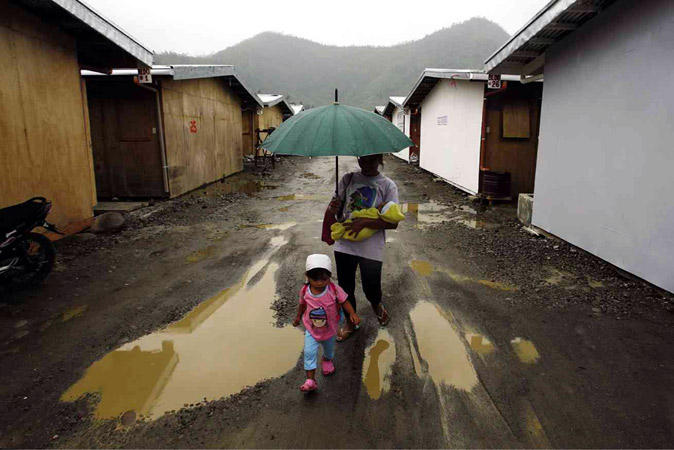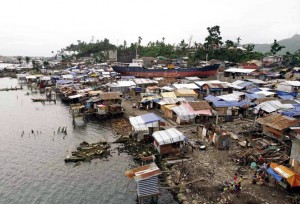Tacloban hobbles on road to recovery

FOR SOME residents of Tacloban City, living in bunkhouses built on dirt road and where there is no privacy is better than living on the streets and in darkness. RAFFY LERMA
Geraldine Glory, who is in full pregnancy, is having mixed emotions. She is excited to give birth to her second child but has not prepared anything for it. She also worries about the future of her growing family.
Glory and her common-law husband, Kycian de Dios, live in a tent with her 3-year-old daughter at Tacloban Convention Center and rely on relief items being distributed by the Department of Social Welfare and Development. Their house was among the thousands destroyed when storm surges spawned by Supertyphoon “Yolanda” leveled every structure in its path.
Both in their 20s, the couple want to rebuild their house in San Jose District in Tacloban City in Leyte province but cannot do so because its distance of within 6 meters from the shoreline has been declared a no-build zone.

THE DESIRE to rise from the destruction wrought by Supertyphoon “Yolanda” manifests itself in the form of makeshift homes that have been built around a ship that was swept inland by storm surges in Anibong, Tacloban City. RAFFY LERMA
De Dios could not return to his old job as a driver. He lost
his motorcycle to floodwaters spawned by the typhoon.
Article continues after this advertisement“We have not prepared anything for our second baby—no baby clothes, no diapers. Living in this tent is a daily reminder that we don’t live a normal life,” Glory said.
Article continues after this advertisementTheir plight reflects the current condition of many residents of Tacloban, which is considered ground zero after a wall of seawater reaching as high as 6 meters crashed into structures on Nov. 8 last year. At least 2,600 people were killed while a thousand more were missing.
Three months after the devastation, Tacloban is still hobbling toward recovery.
Police officials maintain that the city is peaceful. Their records showed only four crimes against persons and eight against properties during the first week of January, much lower than the 44 and 137 reported, respectively, for the same period last year.
A total of 1,584 families (6,587 people) are still staying in 11 evacuation shelters, mostly in public schools. About 100 have already moved to bunkhouses located at Motocross in the city’s Apitong area, said Derrick Anido, city disaster risk reduction and management officer.
The presence of evacuees has affected the holding of classes on several campuses, including Rizal Central School, Kapangian Central School, Eastern Visayas State University, San Fernando Elementary School, San Jose Central School and Leyte National High School, which are among the biggest public schools in terms of student population.
They occupy the classrooms while the students go to makeshift classrooms.
Other displaced families have been sheltered at People’s Center, Grace Baptist Church, Street Light office (a nongovernment organization), the health center of Barangay 83-A and the Astrodome.
Much of Tacloban is still without power. Most street lights are not energized.
As of the first week of February, Leyte II Electric Cooperative Inc. (Leyeco II) had supplied power to only 7,288 households in the city or one-fifth of the total number of 51,065 households in Tacloban and the towns of Palo and Babatngon.
Ma. Rosario Avestruz, general manager of Leyeco II, said she hoped that power would be fully restored to all its 35,937 member-consumers in Tacloban by March.
The lack of power supply has forced some businesses to shorten their working hours because they rely on generator sets. Robinsons Mall, for one, is open from 8 a.m. to 4 p.m. instead of the usual 10 a.m. to
9 p.m.
The three branches of Gaisano shopping mall have yet to reopen, possibly in May.
However, most of the groceries, drug and hardware stores, bakeshops, salons and food chains are open from
8 a.m. to 5 p.m. Banking hours are from 8 a.m up to 5 p.m., instead of the usual 9 a.m. to
3 p.m.
Even government workers leave their offices before 5 p. m.
Communications lines, particularly land lines, have yet to be restored.
Of the more than 200 Internet cafés operating before Yolanda, only four are back in business.
Ryan Navarro, 33, an Internet café owner, said he lost his computer sets to the typhoon but was able to buy six new ones.
Local businesses have yet to recover. Less than five percent or only 607 of the 15,000 establishments in the city had renewed their business licenses as of Feb, 5, according to the City Licensing Office. Only 12 applied for new licenses, it said.
Tacloban collected P22.26 million from the fees generated through the renewal of business licenses and the issuance of new permits. The figures are below the P79.20 million it collected in January and February last year.
“Of course, we clearly understand why our income is low. Our businessmen were hit hard by Yolanda. Several of them suffered heavy losses,” said city treasurer Zosima Cordano.
The city government has offered local businessmen a
six-month moratorium on the payment of taxes, or up to end of June, to give them time to recoup their losses.
Rhoel Ladera, 37, who designs and manufactures tarpaulins, said he chose to restart the business he started 17 years ago despite the economic difficulty.
“I am an optimistic person. I am confident that we can rebound from this setback,” Ladera said.
Incidentally, Ladera is among the 17 business owners from Tacloban and other parts of Leyte and from Guiuan town in Eastern Samar province who have received loans from the Department of Trade and Industry.
Trade Secretary Gregory Domingo said loans ranging from P200,000 to P2 million were offered to help the businessmen start anew.
Hopefully, the money assistance will help jump-start the local economy and bring back the robust business environment in Tacloban before the storm.